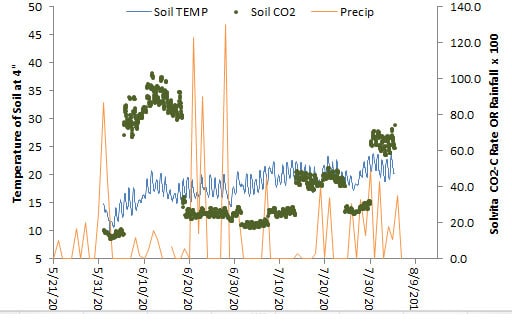Interesting and potentially very valuable relationships between CO2 respiration and soil conditions have recently been revealed in a soil monitoring project using the Solvita basal CO2 test. At the Woods End Farm, staff take a soil sample each week and perform in-situ soil respiration (Solvita Basal), without processing the soil, thereby avoiding artifacts. This test therefore shows respiration in the soil under ambient moisture conditions. Using the Arrhenius algorithm the CO2-rate is corrected for actual soil temperature at the time of testing (shown in blue recorded every hour at 10cm-4″ depth since June 1). Rainfall events are noted. and clearly coincide with bumps in soil respiration.
 A soil dry spell in May followed by a burst of rain June 1 appears to have triggered a CO2 burst effect lasting 2 weeks in the field (jump in CO2 in ambient samples). The respiration subsided drastically after heavy rains in June pushed soil saturation high. CO2 rate then rose slowly as soil temperature increased into summer.
A soil dry spell in May followed by a burst of rain June 1 appears to have triggered a CO2 burst effect lasting 2 weeks in the field (jump in CO2 in ambient samples). The respiration subsided drastically after heavy rains in June pushed soil saturation high. CO2 rate then rose slowly as soil temperature increased into summer.
Integrating all the factors, the Solvita team inputed the water-soluble C:N ratio from soil tests, to correct for N-min efficiency from CO2. This reveals that this soil may have produced 155 lb/a N in this time. “For soils as we have here with OM content above 5% this is a potentially useful number – the only thing missing is estimating de-nitrification rates when soil is very wet.”
The Solvita team is pursuing this line of work to develop a field basal method to derive real-time CO2 and N-min, using standard corrections for temperature. It requires growers to monitor temperature and CO2 frequently, and this is easy with Solvita and simple dataloggers. “These are just preliminary data, yet it’s exciting to see how with some simple tools and procedures, especially recording soil temperature, the Basal test could help reveal important seasonal variations that explain why it is not easy to correlate CO2 rates with N-mineralization. Here we get a glimpse at what is really going on in the soil in the course of the growing season”. The team has also concluded that soil temperatures are routinely much lower than expected even with high ambient air temps, especially if crops cover the soil. Brinton will be recommending labs running CO2 respiration de-standardize the test to reflect soil temperatures in the regions where they are testing.
